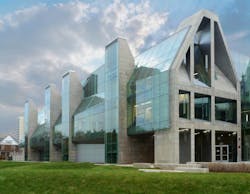Look at the façade of Gordon Parks Arts Hall, located on the University of Chicago Lab School campus. The beautiful envelope design, with sharp angles and breaks in the glass, incorporates ample daylighting, but the unique exterior posed a challenge: How would the facility manager/building owner find effective solar shading for the angled windows?
Bryan Biggers III, president of Beverly Venetian Blind Company, who took on the project, turned to Draper's Solar Control Solutions division for a custom solution that would appreciate the ambiance and provide comfortable, energy-efficient sunlight control. The shading system needed to fit the windows properly without wasting space and help stave off heat gain.
A Custom Solution
A standard shading system at Gordon Park Arts Hall would have hung straight down into the space, several feet in front of the unique windows.
(Photo: University of Chicago Art Lab. Credit: Barry Rustin)
After much collaboration between Biggers and Draper, designers created an innovative, motorized shade system on tracks. Operated via wall switch, the window treatment uses re-directional rollers to move each individual shade along the changes in the windows’ slope. The idea was based on Draper’s Motorized FlexShade and Skylight 2.0 technologies.
(Photo: Window treatment closeup. Credit: Barry Rustin)
Innovative, collaborative solutions helped the team overcome many challenges. These included managing the different brackets required, and making on-site adjustments and fabrication changes during installation.
“We used 3D engineering rapid prototyping machines, and developed a process using printed plastic inserts that allowed us to use a gym equipment tubing bender to bend u-channel,” Childress says. He adds, “The project continued to be challenging as installation got underway. Installers from Beverly Venetian Blind Company had to make some on-site adjustments.”
Buildings Podcast
System 4500 Doors and Windows: Editors’ Choice
Listen to how REHAU’s System 4500 windows and doors are an affordable way to let in daylight and fresh air without the potentially costly pitfalls posed by other window materials.
Staving Off Heat Gain
The need for shading in the space was critical. “With the large amount of glazing and unique angles, glare and heat gain are a big problem,” Childress adds. “The shading system mitigates any glare or heat gain. The 3% open dark fabric (Mermet E Screen Charcoal/Gray) also allows some view-through to the outside even when deployed.”
With Draper’s custom solution, the space is now more comfortable to work in when sunlight hits the glazing. When the shading isn’t needed, the motorized system can retract, and faculty and staff can enjoy full use of the unique glazing.
Nontraditional envelopes can bring what seem like insurmountable challenges, whether it’s cleaning efficiently or having an effective window treatment.
But custom solutions are out there—and they can overcome those challenges when needs and goals are identified, and the right players collaborate.
Two handpicked articles to read next:
About the Author

Sarah Kloepple
Associate Editor
Sarah joined the BUILDINGS team as an associate editor in August 2018. She is a graduate of the Missouri School of Journalism, where her focus was magazine writing. She's written and edited for numerous publications in her hometown of St. Louis.
